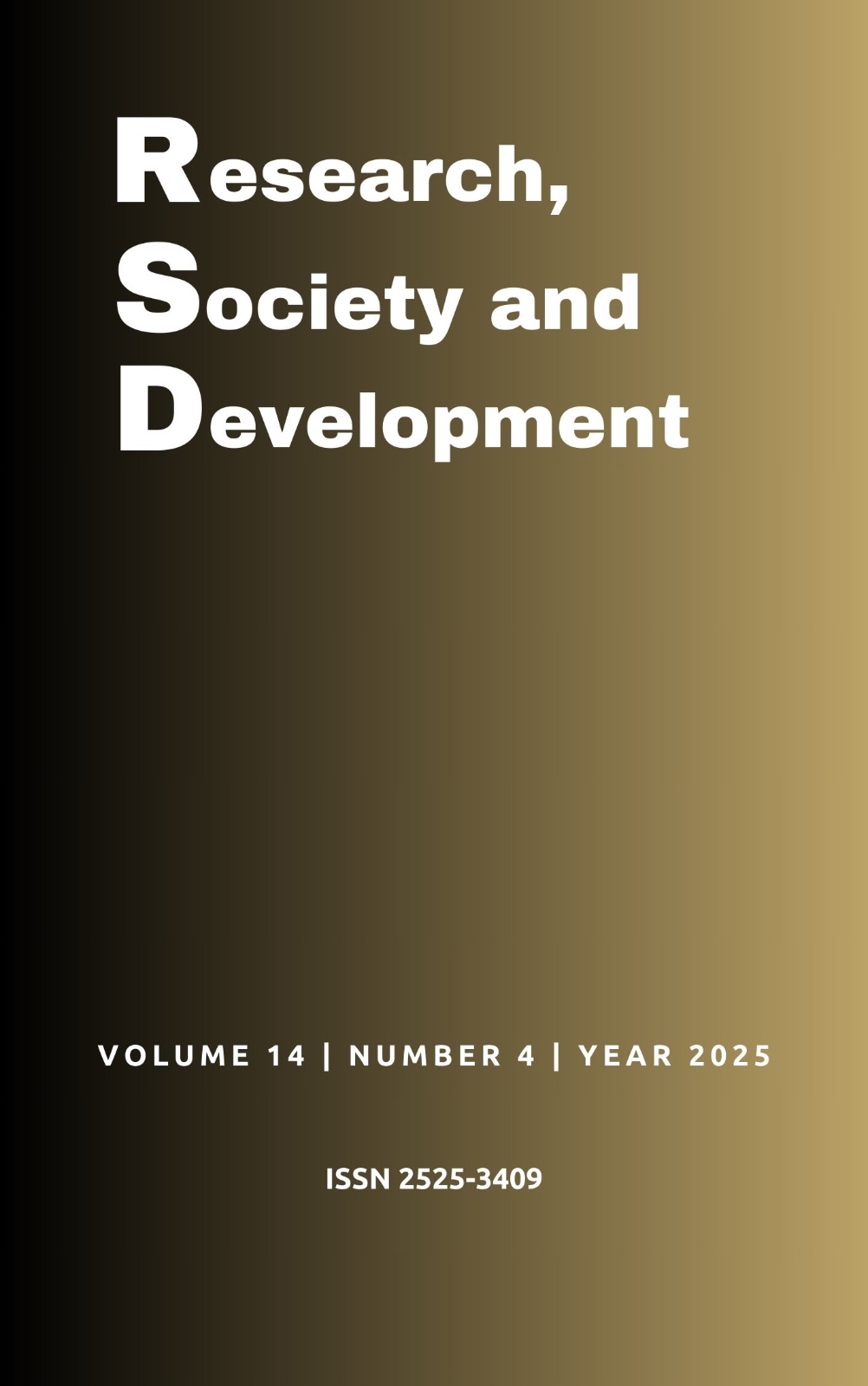Epidemiological aspects of interpersonal and self-harm violence in Paiçandu-PR, in the period from 2013 to 2023
DOI:
https://doi.org/10.33448/rsd-v14i4.48653Keywords:
Interpersonal violence, Self-harm, Epidemiology, Public Health.Abstract
Objective: To analyze the epidemiological profile of reports of interpersonal and self-inflicted violence in the region of Paiçandu - PR between 2013 and 2023. Methods: The quantitative and descriptive study used data from the National System of Injuries and Notifications (SINAN) to obtain epidemiological data and structure the research. Results: female adults, white race/color, age range between 19 and 44 years, complete high school were the main victims. There were 979 reported cases, of which 348 were self-inflicted injuries. Of the total violence data analyzed, 396 cases were caused by family members, specifically mother (14%) and spouse (13%), with the highest registration rate. The highest incidence of cases was in 2021 with 195 reports, corresponding to 20% of the reports in the period analyzed. Regarding the evolution of cases of violence, 928 records were blank, making it impossible to analyze the outcome of the events due to the lack of records. It is concluded that interpersonal violence and self-harm are public health problems. It is important to train health teams to correctly record notifications, since without this epidemiological data, prevention and intervention strategies for violence are compromised.
Downloads
References
Andrade, C. M. D., Teixeira, G. T., França, T. B., Rambo, M., Trevisan, M. G., Casaril, E., & Costa, L. D. (2020). Violência interpessoal e autoprovocada: caracterização dos casos notificados em uma regional de saúde do paraná. Cogit. Enferm.(Online). 25, e63758-e63758. doi: https://doi.org/10.5380/ce.v25i0.63758.
Barufaldi, L. A., Souto, R. M. C. V., Correia, R. S. D. B., Montenegro, M. D. M. S., Pinto, I. V., Silva, M. M. A. D., & Lima, C. M. D. (2017). Gender violence: a comparison of mortality from aggression against women who have and have not previously reported violence. Ciência & saúde coletiva, 22(9): 2929-38. doi: 10.1590/1413-81232017229.
Brasil. (2011). Viva: instrutivo de notificação de violência doméstica, sexual e outras violências. Brasília: Ministério da Saúde, DF, Brasil. Brasil. (2016). Portaria n° 204, de 17 de fevereiro de 2016. Brasília: Ministério da Saúde.
Brasil. Ministério da Saúde (2024). Guia de Vigilância em Saúde. (6ª ed. rev.). Brasília: Ministério da Saúde.
Brasil. (2025). Sistema de Informação de Agravos de Notificação - Sinan. Brasília: Ministério da Saúde, 67p.
Brasil. Ministério da Saúde (s.d.). Violência - Indicadores, Ações e Programas - Acesso à Informação. Brasília: Secretaria de Vigilância em Saúde. https://svs.aids.gov.br/daent/acesso-a-informacao/acoes-e-programas/estudos/violencia/.
Castro, L. O., Campos, M. D., Campos, N. D., & Oliveira, P. H. A. (2024). Panorama epidemiológico da violência autoprovocada. Lumen Et Virtus. 15(39), 3066-72.
Ferri, J., Hubner, J., Borges, S., de-Oliveira, L. S., & Augusto, P. (2023). A notificação compulsória por violência interpessoal ou autoprovocada: um estudo epidemiológico. Revista Brasileira de Medicina de Emergência. 3(1), 14-8. doi: 10.5935/2764-1449.20230004.
Guerreiro, D. F., Sampaio, D. (2013). Comportamentos autolesivos em adolescentes: uma revisão da literatura com foco na investigação em língua portuguesa. Revista portuguesa de saúde pública, 31(2), 213-222.
Lemes, A.R.B. (2017). Dominação masculina e violência doméstica: um estudo de caso no município de Paiçandu-PR. São Paulo, Brasil: FLACSO, Sede Brasil.
Martins, A.K.R.S., & Nunes, C.J.R R. (2024). A importância da notificação de violência interpessoal e/ou autoprovocada no SINAN no âmbito da atenção básica: relato de experiência. Health Residencies Journal-HRJ, 5(23).
Pereira, A.S., Shitsuka, D.M., Parreira, F.J., & Shitsuka, R. (2018). Metodologia da pesquisa científica. [free e-book]. Editora da UFSM.
Prefeitura Municipal de Paiçandu. (2025). Nossa Cidade: História da Cidade. Paiçandu, BR.
Sardinha, L., Maheu-Giroux, M., Stöckl, H., Meyer, S.R., & García-Moreno, C. (2022). Global, regional, and national prevalence estimates of physical or sexual, or both, intimate partner violence against women in 2018. The Lancet, 399(10327), 803-13.
Secretaria de Estado da Saúde do Paraná. (2023). Plano Decenal de Segurança Pública e Cidadania: Relatório 2023. Curitiba, BR.
Shitsuka, R. et al. (2014). Matemática fundamental para tecnologia. Saraiva Educação.
Silva, E. N., Marques, G. L. W. B., & Wanzinack, C. (2023). Perfil dos casos de violência interpessoal e/ou autoprovocada no Paraná entre 2015 e 2018. Revista de Saúde Pública do Paraná. 6(1), 1-15.
Souza, I. T., Passos, T. S., Almeida, L. M., & Almeida-Santos, M. A. (2021). Epidemiological profile of interpersonal violence in Brazil between 2015 and 2019. Res Soc Develop. 10(16), e29101623204. Doi: https://doi.org/10.33448/rsd-v10i16.23204. https://rsdjournal.org/index.php/rsd/article/view/23204.
Venzi, M. L. C. S. (2015). Violência e ficha de notificação: O que nós, profissionais de saúde, temos a ver com isso. Monografia de Especialização. CESMAD, Brasília, DF, Brasil.
World Health Organization (WHO) (2002). Informe mundial sobre la violencia y la salud: Resumen. Organización Panamericana de la Salud-Oficina Regional para las Américas de la Organización Mundial de la Salud. Washington, D.C, USA.
World Health Organization (WHO) (2014). Global status report on violence prevention. Geneve, Switzerland.
Downloads
Published
Issue
Section
License
Copyright (c) 2025 Daysa Ione Braga Amadei Rodrigues; Giovani Otavio Manzano; Lilian Zolet Bergonzini

This work is licensed under a Creative Commons Attribution 4.0 International License.
Authors who publish with this journal agree to the following terms:
1) Authors retain copyright and grant the journal right of first publication with the work simultaneously licensed under a Creative Commons Attribution License that allows others to share the work with an acknowledgement of the work's authorship and initial publication in this journal.
2) Authors are able to enter into separate, additional contractual arrangements for the non-exclusive distribution of the journal's published version of the work (e.g., post it to an institutional repository or publish it in a book), with an acknowledgement of its initial publication in this journal.
3) Authors are permitted and encouraged to post their work online (e.g., in institutional repositories or on their website) prior to and during the submission process, as it can lead to productive exchanges, as well as earlier and greater citation of published work.


